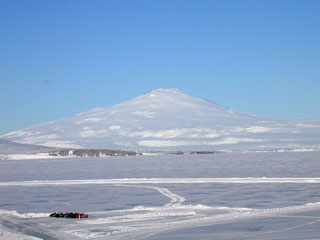Report on Melbourne (Antarctica) — March 1983
Scientific Event Alert Network Bulletin, vol. 8, no. 3 (March 1983)
Managing Editor: Lindsay McClelland.
Melbourne (Antarctica) Fumarolic activity unchanged since 1972
Please cite this report as:
Global Volcanism Program, 1983. Report on Melbourne (Antarctica) (McClelland, L., ed.). Scientific Event Alert Network Bulletin, 8:3. Smithsonian Institution. https://doi.org/10.5479/si.GVP.SEAN198303-390015
Melbourne
Antarctica
74.35°S, 164.7°E; summit elev. 2732 m
All times are local (unless otherwise noted)
". . . Observations in December 1972 indicated three main areas of steaming ground in which temperatures as high as 59°C were recorded at depths of 0.25 m. Numerous fumarolic ice towers were scattered throughout the summit area (Lyon and Giggenbach, 1974). Two members of the U.S. Antarctic Research Program climbed the mountain in January 1983. No change was noted in the number, size, and distribution of ice towers and steaming ground from the 1972 reports. Measured ground temperature temperatures were also similar to those in 1972. There was no evidence of any change in the activity over the last 10 years."
Reference. Lyon, G.L., and Giggenbach, W.F., 1974, Geothermal activity in Victoria Land, Antarctica: New Zealand Journal of Geology and Geophysics, v. 17, p. 511-521.
Further Reference. Keys, J.R., McIntosh, W.C., and Kyle, P.R., 1983, Volcanic activity of Mount Melbourne, North Victoria Land: Antarctic Journal of the United States, 1983 review, v. 18, no. 5, p. 10-11.
Geological Summary. Mount Melbourne is a large undissected stratovolcano along the western coast of the Ross Sea in Antarctica's northern Victoria Land. The glacier-covered edifice lies at the center of a volcanic field containing both subglacial and subaerial vents along a dominantly N-S trend. A large number of scoria cones, lava domes, viscous lava flows, and lava fields are exposed at the summit and upper flanks. A number of very young-looking cones are located at the summit and on the flanks. Tephra layers are found within and on top of ice layers, and the most recent eruption was estimated to have occurred between 1862 and 1922. The volcano displays fumarolic activity that is concentrated along a NNE-SSW line cutting through the summit area and along a line of phreatomagmatic craters on the southern rim of the summit crater. Prominent ice towers and pinnacles were formed from steam condensation around fumarolic vents.
Information Contacts: P. Kyle, New Mexico Inst. of Mining and Tech.

